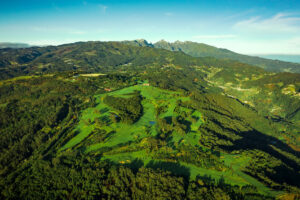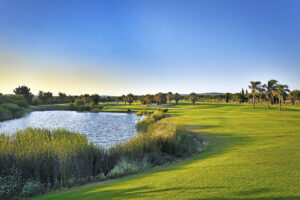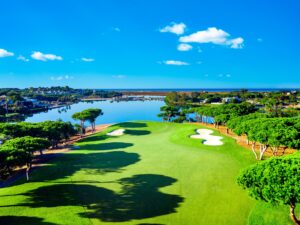How some clubs in Portugal irrigate their courses
Related Articles
This summer a number of UK golf courses struggled to cope with irrigation demands, caused by the hot weather. Here, we look at three venues in Portugal, which have all invested in new irrigation systems recently, to see how they deal with the drought-like conditions the UK experienced in 2022 every year.
Clube de Golf Santo da Serra in the Portuguese island of Madeira’s has installed a new state-of-the-art irrigation system – and in doing so has reduced its water consumption by around 66 percent.
Having installed a new irrigation system on the Machico and Desertas nine-hole loops at the end of 2021, Clube de Golf Santo da Serra has now completed similar work on 3,193-yard Serras course – reducing its water consumption by two thirds so that just 750m³ a day is now needed to help ensure optimum course conditions all-year round.
In addition, the club has renovated the four on-course lakes that it uses for irrigation, installing an interconnecting system between all of them to improve access to water so that all areas of the 27-hole layout can easily be watered whenever necessary. It has also installed a new pumping system in the lake on the fourth hole to improve irrigation efficiency. It is estimated that the combined capacity of the lakes is around 40,000m³, a volume that will reinforce the storage capacity of the Lagoa do Santo system.
Ricardo Vieira, sales and marketing director at Clube de Golf Santo da Serra, said: “The system that we had was outdated and primitive and required 2,200m³ of water a day to maintain all the grass playing surfaces.
“What we have now is a smarter, more efficient solution to all our golf course irrigation needs, giving us an integrated remote management system that will be a pioneer in hydraulics management on golf courses.”
The Laguna Golf Course at Dom Pedro Hotels & Golf Collection on the Algarve reopened in the summer of 2022 after undergoing an extensive requalification to improve the overall quality of the course as part of a new dimension to the resort’s well-renowned golfing portfolio.
The requalification of the Dom Pedro Laguna Golf Course was based on three key pillars; definition, contras, and uniformity; designed to create a consistent look-and-feel throughout the layout and showcase increased playability for golfers of all abilities.
Upon re-opening, golfers can now clearly identify all areas of play, along with the contrast given by the different tones of grass and cutting heights. One hundred percent Bermuda grass has been installed across all the greens, fairways and tee boxes; restoring them with improved aesthetics and increased water efficiency, to provide quality conditioning 365 days of the year.
In addition, the course has seen an entirely new Rain Bird IC irrigation system fitted to increase coverage and reduce water consumption by up to 30 percent across the playing surface, whilst all bunkers have been rejuvenated with a fresh new layer of white sand for greater compaction, texture and reliability.
Pietro Dal Fabbro, chief executive officer at Dom Pedro Hotels & Golf Collection, stated: “The Dom Pedro Laguna Golf Course is one of the golf courses in the Algarve that has been subject to continuous improvements over the years. We determined because of the pandemic that this would be the best time to take a step forward with a more incisive requalification of the Dom Pedro Laguna Course, raising the quality of the course and meeting the expectations of sustainable development.”
Rui Grave, head greenkeeper at Dom Pedro Golf, added: “Golfers will now be able to find a golf course that consumes 20 percent less energy and fertiliser, as well as up to 50 percent less water. It will now be possible to identify protected areas for the reservation of the local avifauna, but also all the areas of the game, together with the contrast produced by the different shades of grass and heights of cut. All the fairways have been restored to their original layout, the greens have become faster and firmer, the bunkers revitalised and the rough made more consistent for a greater playing experience.”
Nestling in the heart of the Ria Formosa Natural Park, Quinta do Lago has always been passionate about the environment – only nine percent of the resort has been built on with the rest devoted to golf, water and lakes and green spaces.
Following the Golf Environment Organisation’s OnCourse programme with a goal to become certified, the Portuguese resort promotes a multi-tiered plan with the emphasis on outdoor living and incorporates three key principles: to foster nature, conserve resources and support the community.
As well as featuring improved sustainability on its three 18-hole championship courses – including a €7m makeover of the iconic South Course – the resort has adopted an enhanced approach to conservation across other sectors of its business including at its world-class sports hub The Campus, The Magnolia Hotel, its 14 bars and restaurants and general resort services.
Recent measures adopted include:
Turfs and grasses. The fairways and tees on the South Course have been replaced with Hybrid Bermudagrass Tifway 419. The maintained rough has been changed to Kikuyugrass, which is now endemic in the region and will continually lower the resort’s irrigation and resource consumption.
Irrigation. In 2020, Quinta do Lago changed its irrigation practices to be based on evapotranspiration by taking information from its on-site weather stations. This method of irrigation gives the plant exactly what was lost from the previous 24 hours, plus enough water to grow and stay healthy. Last winter the resort invested in a major upgrade of the irrigation pumps on the South Course which will improve efficiency and save water and power. The same upgrades are planned on the North Course this winter. Rather than aiming for an unrealistic saving year-on-year, the resort aims to keep consumption below the past five years’ average consumption. This will remove the irregularities of rainfall and heatwaves as well as providing more accurate targets to be set.
Planting and re-naturalisation using native plant species (mastic tree, salvia cistus, kermes oak, olive tree, strawberry tree, carob tree, among other options), developing a local biodiverse landscape that creates a genuine golf experience, and the purchase of a new electric golf buggy fleet to avoid using of fuel.
The environmental improvements do not stop there. The club has also built shelters for insects, placed nest-boxes for birds, constructed bee houses, introduced native plants to control invasive exotic species and removed single plastic usage from its restaurants. And to showcase these improvements, it has erected information boards in its golf courses and set up nature trails.




























